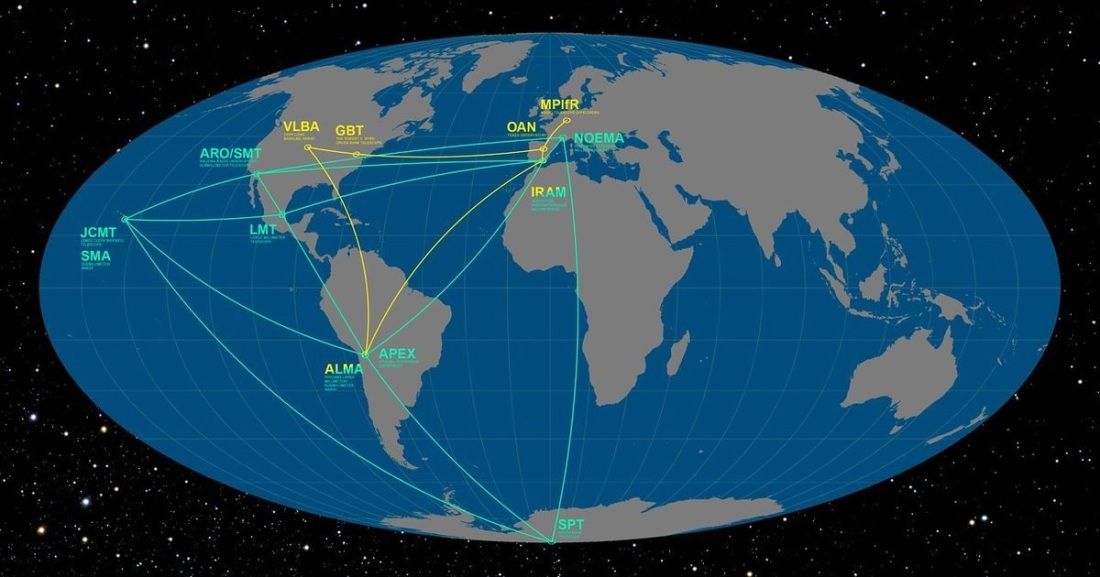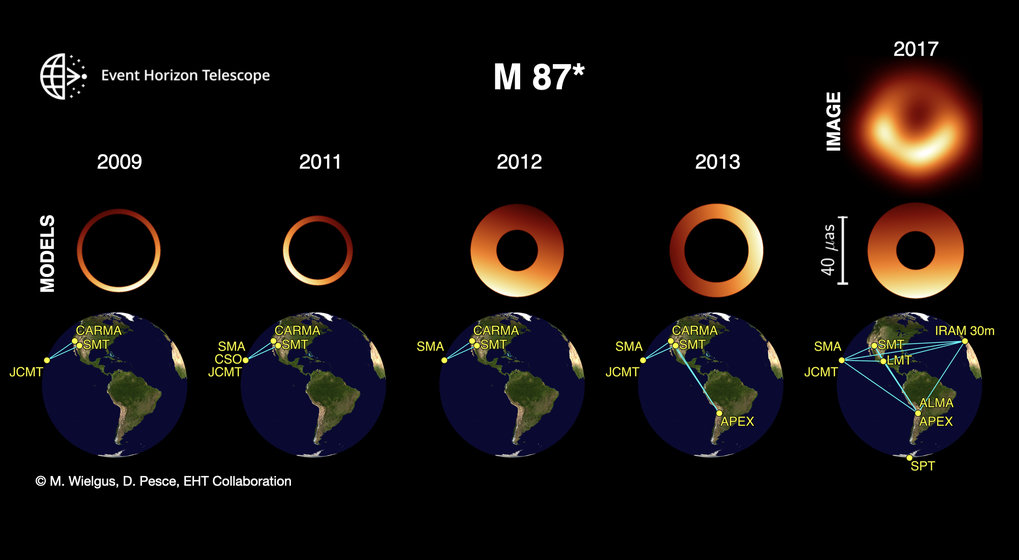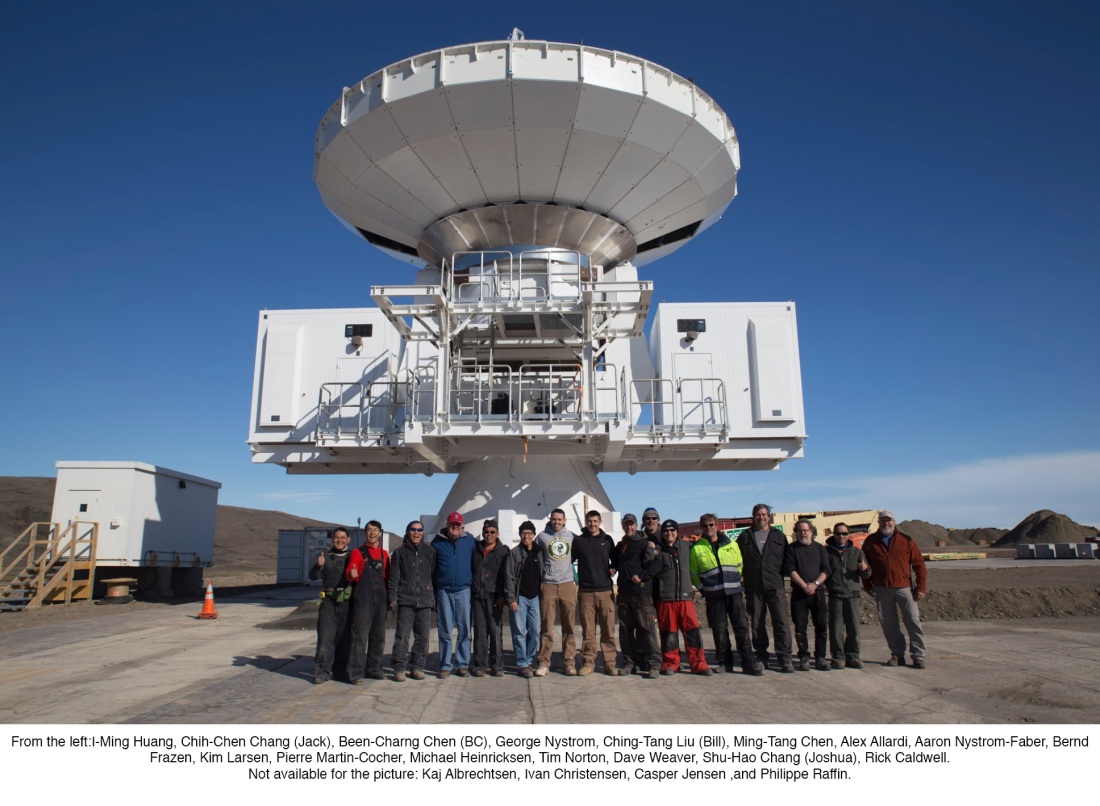
From Max Planck Institute for Radio Astronomy
September 23, 2020
Dr. Norbert Junkes
Press and public relations
Max Planck Institute for Radio Astronomy, Bonn
+49 2 28525-399
njunkes@mpifr-bonn.mpg.de
Prof. Dr. J. Anton Zensus
Max Planck Institute for Radio Astronomy, Bonn
+49 228 525-378
azensus@mpifr-bonn.mpg.de
Astronomers of the Event Horizon Telescope conclude from archive data how the surroundings of the mass monster in the galaxy M 87 have changed.
In the center of the giant galaxy Messier 87 lurks a giant black hole.

The image of this mass monster published last year and obtained with the Event Horizon Telescope (EHT) went around the world.

Now the EHT team has analyzed archive data from 2009 to 2013, some of which are still unpublished. The researchers found that the ring-shaped shadow around the black hole is indeed always present, but changes its orientation and brightness distribution – the ring seems to be glittering. The participation of the European APEX telescope in Chile and the IRAM 30-meter telescope co-financed by the Max Planck Society on Pico Veleta in the Spanish Sierra Nevada played an important part in this discovery.



Snapshots of the M 87* black hole obtained through imaging / geometric modeling, and the EHT array of telescopes in 2009 – 2017. The diameter of all rings is similar, but the location of the bright side varies. The variation of the thickness of the ring is most likely not real and results from the limited number of participating observatories in earlier experiments. © M. Wielgus, D. Pesce & EHT Collaboration.
“The results announced in April 2019 show an image of the shadow of a black hole, consisting of a bright ring formed by hot plasma swirling around the black hole in Messier 87, and a dark central part, where we expect the event horizon to be”, reminds Maciek Wielgus, astronomer at Harvard University, and lead author of the new paper.
However, those results were based only on observations performed throughout a one-week long time window in April 2017, which is far too short to see if the ring is evolving over longer time scales. Even after careful data analysis, therefore some open questions with regard to the stationarity of the ring features over time remained. For that reason, an investigation of earlier archival data was considered.
The 2009 – 2013 observations consist of far less data than the ones performed in 2017, making it hard to image Messier 87 without a-priori assumptions. For the available archive data, the EHT team used statistical modeling based on geometrical assumptions to look at changes in the appearance of the black hole in M 87 (M 87*) over time.
Expanding the analysis to the 2009-2017 observations, scientists have shown that Messier 87* adheres to theoretical expectations. The black hole’s shadow diameter has remained consistent with the prediction of Einstein’s theory of general relativity for a black hole of 6.5 billion solar masses. The morphology of an asymmetric ring persists on timescales of several years, in a consistent manner which provides additional confidence about the nature of M 87* and the origin of its shadow.
But while the diameter of the ring remained constant over time, the EHT team found that the data were hiding a surprise. Thomas Krichbaum, astronomer at the Max Planck Institute for Radio Astronomy and one of the leading authors of the publication, says: “The data analysis suggests that the orientation and fine structure of the ring varies with time. This gives a first impression on the dynamical structure of the accretion flow, which surrounds the event horizon”. He adds: “Studying this region will be crucial for a better understanding of how black holes accrete matter and launch relativistic jets.”
The gas falling onto a black hole heats up to billions of degrees, ionizes and becomes turbulent in the presence of magnetic fields. Since the flow of matter is turbulent, the ring brightness appears to glittering with time, which challenges some theoretical models of accretion.
“The monitoring of the time variable structure of Messier 87 with the EHT is a challenge that will keep us busy over the next few years,” says Anton Zensus, Director at the Max Planck Institute for Radio Astronomy and Founding Chairman of the EHT Collaboration Board. „We are working in the analysis of the 2018 data, and preparing newer observations in 2021, with the addition of new sites such as the NOEMA Observatory in France, the most powerful radio telescope of its kind in the Northern Hemisphere and also co-financed by the Max-Plack-Gesellschaft as well as the Greenland Telescope, and Kitt Peak in Arizona,” adds Zensus.



The enhanced imaging capabilities provided by this extended array will provide a more detailed view on the shadow of the black hole Messier 87* and on the innermost jet of the Messier 87 radio galaxy.
Science paper:
Monitoring the Morphology of M87* in 2009–2017 with the Event Horizon Telescope
The Astrophysical Journal
Cosmic twinkling. An animation representing one year of Messier 87* image evolution according to numerical simulations. Measured position angle is shown along with a 42 microarcsecond ring. For a part of the animation, image blurred to the EHT resolution is shown. © G. Wong, B. Prather, Ch. Gammie, M. Wielgus & EHT Collaboration.
See the full article here .
See also the full article from MIT Haystack here.
five-ways-keep-your-child-safe-school-shootings
Please help promote STEM in your local schools.


MPIFR/Effelsberg Radio Telescope, Germany
The Max Planck Institute for Radio Astronomy (German: Max-Planck-Institut für Radioastronomie) is located in Bonn, Germany. It is one of 80 institutes in the Max Planck Society.
By combining the already existing radio astronomy faculty of the University of Bonn led by Otto Hachenberg with the new Max Planck institute the Max Planck Institute for Radio Astronomy was formed. In 1972 the 100-m radio telescope in Effelsberg was opened. The institute building was enlarged in 1983 and 2002.
The institute was founded in 1966 by the Max-Planck-Gesellschaft as the “Max-Planck-Institut für Radioastronomie” (MPIfR).
The foundation of the institute was closely linked to plans in the German astronomical community to construct a competitive large radio telescope in (then) West Germany. In 1964, Professors Friedrich Becker, Wolfgang Priester and Otto Hachenberg of the Astronomische Institute der Universität Bonn submitted a proposal to the Stiftung Volkswagenwerk for the construction of a large fully steerable radio telescope.
In the same year the Stiftung Volkswagenwerk approved the funding of the telescope project but with the condition that an organization should be found, which would guarantee the operations. It was clear that the operation of such a large instrument was well beyond the possibilities of a single university institute.
Already in 1965 the Max-Planck-Gesellschaft (MPG) decided in principle to found the Max-Planck-Institut für Radioastronomie. Eventually, after a series of discussions, the institute was officially founded in 1966.
The Max Planck Society for the Advancement of Science (German: Max-Planck-Gesellschaft zur Förderung der Wissenschaften e. V.; abbreviated MPG) is a formally independent non-governmental and non-profit association of German research institutes founded in 1911 as the Kaiser Wilhelm Society and renamed the Max Planck Society in 1948 in honor of its former president, theoretical physicist Max Planck. The society is funded by the federal and state governments of Germany as well as other sources.
According to its primary goal, the Max Planck Society supports fundamental research in the natural, life and social sciences, the arts and humanities in its 83 (as of January 2014)[2] Max Planck Institutes. The society has a total staff of approximately 17,000 permanent employees, including 5,470 scientists, plus around 4,600 non-tenured scientists and guests. Society budget for 2015 was about €1.7 billion.
The Max Planck Institutes focus on excellence in research. The Max Planck Society has a world-leading reputation as a science and technology research organization, with 33 Nobel Prizes awarded to their scientists, and is generally regarded as the foremost basic research organization in Europe and the world. In 2013, the Nature Publishing Index placed the Max Planck institutes fifth worldwide in terms of research published in Nature journals (after Harvard, MIT, Stanford and the US NIH). In terms of total research volume (unweighted by citations or impact), the Max Planck Society is only outranked by the Chinese Academy of Sciences, the Russian Academy of Sciences and Harvard University. The Thomson Reuters-Science Watch website placed the Max Planck Society as the second leading research organization worldwide following Harvard University, in terms of the impact of the produced research over science fields.
